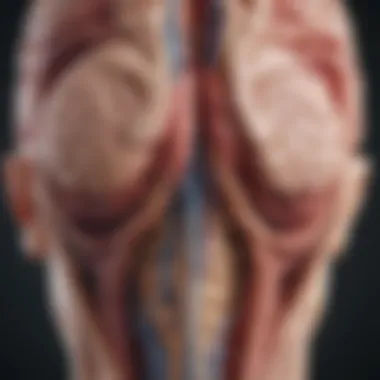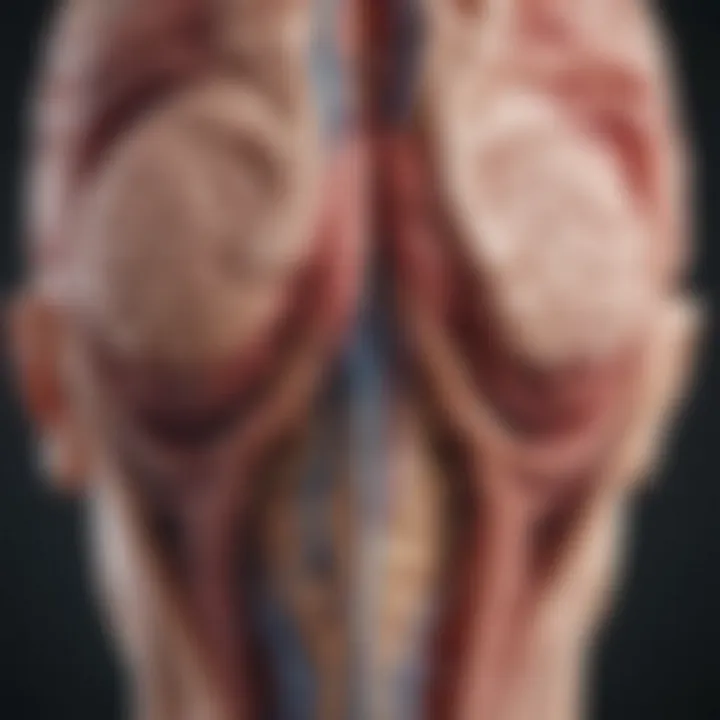Aneurysms and Subarachnoid Hemorrhage Explained


Intro
A brain aneurysm presents a silent threat—like a ticking time bomb nestled within the intricacies of the vascular system. Defined simply, it is an abnormal dilation in the blood vessels of the brain, and while it often exists without noticeable symptoms, the potential for rupture makes it a cause for concern. When an aneurysm bursts, it can lead to a severe condition known as subarachnoid hemorrhage, where blood leaks into the space surrounding the brain. This is not merely a medical mishap; it can have profound, life-altering consequences.
Understanding the nuances of these conditions is crucial—not just from a clinical perspective, but also for educational and preventive measures. This article aims to decode the relationship between aneurysms and subarachnoid hemorrhages, from their physiological foundations to their implications in diagnosis and treatment.
In a world where neurological emergencies can escalate quickly, equipping ourselves with knowledge acts as a first line of defense. Whether you're a student of medicine, an educator, or a researcher, the insights shared here can deepen your grasp of these critical topics.
Research Overview
In embarking on this exploration, it's essential to summarize the key findings relevant to brain aneurysms and subarachnoid hemorrhages. By understanding these results, we can frame the discussion within the broader context of neurological health.
Summary of Key Findings
- Prevalence: Research indicates that nearly 2-5% of the general population may harbor a brain aneurysm, many of which remain undiagnosed.
- Rupture Risk Factors: Age, gender, family history, and lifestyle choices are all factors contributing to the likelihood of an aneurysm rupturing.
- Immediate Consequences: Subarachnoid hemorrhage often presents suddenly, with symptoms like a severe headache, neck stiffness, and loss of consciousness.
Through these insights, it becomes clear that awareness is vital. Addressing risk factors and recognizing symptoms can significantly influence outcomes for individuals affected by these conditions.
Relevance to Current Scientific Discussions
The intricate relationship between aneurysms and subarachnoid hemorrhages is a focal point in contemporary neurology discussions. Ongoing research sheds light on genetic predispositions, potential preventive strategies, and the effectiveness of various treatment modalities. Scientists and medical professionals are engaged in an ongoing dialogue regarding how best to manage and treat these conditions—grounds that fuel advancements in neurological health.
"Knowledge is power. The more we know about aneurysms, the better we can strategize prevention and treatment."
— Dr. Jane Smith, Neurologist
In essence, understanding these subjects not only adds to our individual knowledge but enhances collective health initiatives aimed at reducing morbidity and mortality associated with these serious neurological conditions.
Methodology
To provide a comprehensive overview, it’s also essential to consider the methodologies applied to understand these conditions better and contextualize the findings.
Research Design and Approach
A multi-faceted approach is often employed in studying aneurysms and subarachnoid hemorrhages, incorporating both retrospective and prospective studies. Clinical trials, retrospective reviews of medical records, as well as population-based studies help to establish patterns and correlations.
Data Collection and Analysis Techniques
Data collection not only includes quantitative metrics—such as patient demographics and clinical outcomes—but also qualitative insights derived from patient interviews and clinical observations. Statistical analysis tools such as SPSS and R are frequently used to analyze this data, enabling researchers to identify significant trends and formulate conclusions that can guide clinical practice.
In summary, the investigation into aneurysms and subarachnoid hemorrhages requires a thorough, methodical approach that considers various factors influencing their development and impact. As we delve deeper into this subject, the details surrounding the diagnosis and treatment will further illuminate the paths available for managing these potentially life-threatening conditions.
Prelude to Aneurysms and Subarachnoid Hemorrhage
The relationship between aneurysms and subarachnoid hemorrhage is a critical topic in the field of neurology that has significant implications for patient health and medical practice. Comprehending these conditions not only sheds light on the mechanics of the human vascular system but also prepares us for the challenges faced when they occur together. Aneurysms arise as bulges in blood vessels due to structural weaknesses, often lurking silently without symptoms until it's too late. Meanwhile, subarachnoid hemorrhage, which refers to bleeding in the space between the brain and the tissues covering it, can be life-threatening.
Understanding these dynamics emphasizes the necessity for early detection and intervention. Promptly addressing an aneurysm before it ruptures could make the difference between life and death. The implications of a rupture are dire; it can lead to severe complications, including disability or permanent loss of function. Therefore, studying these areas is crucial not just for professionals, but also for students and researchers who are keen on developing effective treatment strategies.
Also, a robust awareness of the risk factors and clinical presentations associated with both conditions equips healthcare providers with the tools needed to tackle them effectively. Ultimately, this deep dive into aneurysms and subarachnoid hemorrhage serves an important purpose: it aims to provide foundational knowledge necessary for informed discussions, research advancements, and clinical practice improvements.
Defining Aneurysms
Aneurysms are essentially abnormal swellings that form on the walls of blood vessels, commonly occurring in arteries. They can vary significantly in size, shape, and location. Think of them as balloons that form when pressure builds up in a weak section of the vessel wall. Most commonly found in the brain and the aorta, these swellings are often classified into several types:
- Saccular Aneurysms: These appear as a bulge on one side of the blood vessel, resembling a berry hanging off a stem.
- Fusiform Aneurysms: Instead of bulging out on one side, these expand uniformly along a section of the vessel, resembling a spindle.
- Dissecting Aneurysms: Here, blood seeps into the layers of the vessel wall, which can lead to severe complications if not treated.
While many aneurysms are asymptomatic, small ones might not present any noticeable signs. However, larger ones can press on surrounding structures, leading to symptoms such as headaches, vision changes, or even neurological deficits. It's crucial to grasp these definitions and manifestations, as they set the stage for understanding how ruptures occur and their ensuing consequences on health.
Overview of Subarachnoid Hemorrhage
Subarachnoid hemorrhage (SAH) is a medical emergency characterized by bleeding in the subarachnoid space, the area between the brain and the tissues covering it. This space typically contains cerebrospinal fluid, which cushions the brain. An influx of blood disrupts this balance, leading to various significant health issues.
Such hemorrhages are often caused by the rupture of an aneurysm or arteriovenous malformations, but they can also result from traumatic injuries, strokes, or even certain blood thinners. The symptoms of SAH can come on suddenly and include:
- A sudden, severe headache often described as the worst headache of one’s life.
- Nausea and vomiting.
- Stiff neck, sensitivity to light, or altered consciousness.
The consequences of subarachnoid hemorrhage are profound, often resulting in complications like re-bleeding, vasospasm, and even lasting cognitive impairment. Knowing how to identify and respond to these warning signs is crucial for anyone who may encounter these conditions in a healthcare setting or in their personal lives.
"A timely response to indications of subarachnoid hemorrhage can mean the difference between a full recovery and long-term complications."
Both aneurysms and SAH serve as stark reminders of the fragility of the human vascular system. By delving deep into these areas, we can foster enhanced understanding and pave the way toward better management and outcomes.
Anatomical Considerations
Anatomical considerations are crucial for comprehending the complexities associated with aneurysms and subarachnoid hemorrhages. Understanding the structure and location of blood vessels within the brain can shed light on how these conditions develop and progress. A detailed grasp of the relevant anatomy not only aids in diagnosis but also influences the chosen treatment strategies. The interplay between the vascular architecture and these pathological phenomena deserves thorough exploration.
The Blood Vessel Structure
The structure of blood vessels, specifically arteries and veins, is fundamental to our understanding of aneurysms. Arteries, the vessels responsible for carrying oxygen-rich blood away from the heart, have three layers: the intima, media, and adventitia. This layered structure allows them to withstand high pressure from blood flow. The intima is a smooth inner layer, the media contains smooth muscle enabling contraction and dilation, and the adventitia is the outer layer providing support and structure.
An important aspect contributing to aneurysm formation lies in the weaknesses that occur in these layers. When there’s an imbalance in the muscle walls or an accumulation of plaque, regions may become susceptible to abnormal dilation. This dilation, if unchecked, can create an aneurysm. With the rupture of this bulbous dilation, blood can escape into surrounding tissues, leading to potentially catastrophic consequences, including subarachnoid hemorrhage.
Location of Aneurysms in the Brain
Aneurysms tend to occur at specific sites within the brain where arteries bifurcate or branch out, areas often referred to as 'bifurcation points'. Notable locations include the anterior communicating artery and the middle cerebral artery. The specific geometry and hemodynamics at these branches create an environment where stress can exceed the structural integrity of the vessel wall, resulting in an aneurysm.
Understanding the anatomical location of these potential sites is vital to assessing risks. In fact, studies suggest that the majority of intracranial aneurysms are found in the anterior circulation of the brain. This knowledge can guide clinicians in surgical planning and monitoring patients who have been identified as having a predisposition to these maladies.
In summary, the intricate structure of blood vessels combined with the specific locations of aneurysms within the brain forms the backbone of the pathophysiological understanding required for effective treatment and prevention strategies in patients at risk for these life-threatening conditions.
Pathophysiology of Aneurysms
Understanding the pathophysiology of aneurysms is crucial for deciphering how these abnormal blood vessel formations can escalate into serious medical emergencies. Comprehending this topic allows medical professionals, researchers, and students to grasp the underlying mechanisms that lead to aneurysm development and rupture, ultimately guiding the creation of better preventive strategies and treatment options. As we delve into this section, we'll explore the mechanisms of aneurysm formation and the alarming process of rupture and subsequent hemorrhage. These insights shed light on the potential risks and complexities involved in managing aneurysm-related conditions.
Mechanisms of Aneurysm Formation
Aneurysms form when the structural integrity of blood vessel walls is compromised. Several factors can contributet to this weakening, including:


- Genetic predispositions: Hereditary factors can play a significant role in an individual's susceptibility to developing aneurysms. Certain genetic mutations have been linked to abnormalities in the protein components of blood vessel walls, leading to a higher risk of dilation.
- Hemodynamic stress: The constant forces exerted by blood flow can lead to vessel wall injury. Over time, areas under high pressure may begin to bulge, forming an aneurysm. It's like a weak spot in a balloon that, under pressure, starts to stretch out.
- Inflammation: Sometimes, conditions that increase inflammation in the vascular system can weaken vessel walls. Diseases like vasculitis can prompt the immune system to attack blood vessel tissues, contributing to the development of aneurysms.
- Atherosclerosis: Often described as a gradual buildup of plaque in arteries, atherosclerosis can contribute to aneurysm formation. The reduced elasticity in the arterial walls can lead to dilation, creating the potential for future rupture.
The combination of these factors can create the perfect storm, resulting in a blood vessel bulging outward—this bulge can enlarge over time and present serious health implications.
Rupture and Subsequent Hemorrhage
When an aneurysm ruptures, it can unleash a torrent of blood into the surrounding spaces of the brain—a condition known as subarachnoid hemorrhage. The consequences of a rupture are dire and can lead to severe complications, including:
- Acute neurological deficits: Rapid blood accumulation can compress surrounding brain tissues, leading to immediate and severe functional impairments.
- Elevated intracranial pressure: Blood leakage increases pressure within the skull, which can cause a cascade of pain and further complications, including risk of herniation.
- Vasospasms: After a hemorrhage, the affected vessels may constrict abnormally, reducing blood flow to critical areas of the brain. This can lead to secondary strokes and other ischemic events.
- Cerebral edema: The brain may swell in response to the injury, further complicating the clinical picture and making treatment more challenging.
"Instant recognition and intervention are vital; the clock is ticking for every minute that passes after a rupture."
Understanding these mechanisms is the first step toward developing effective treatments and improving patient outcomes. By grasping how aneurysms form and the critical processes triggered by a rupture, healthcare providers and researchers can focus efforts on innovating prevention strategies, enhancing diagnostic techniques, and refining treatment protocols.
Epidemiology
The field of epidemiology plays a crucial role in understanding aneurysms and subarachnoid hemorrhages. By examining the patterns, causes, and effects of these conditions in specific populations, researchers can uncover critical insights that help in shaping public health strategies and medical interventions. Epidemiological studies not only give a glimpse into how widespread these issues are but also illuminate the risk factors and outcomes that affect different demographic groups.
Prevalence of Aneurysms
Aneurysms are often termed silent killers due to their asymptomatic nature in many cases. According to recent studies, the estimated prevalence of cerebral aneurysms in the general population ranges from 2% to 5%. This means that millions might carry such vascular abnormalities without even knowing it. Furthermore, certain populations, particularly those with a family history of aneurysms or other risk factors, may have an increased likelihood of developing them.
Some demographic findings include:
- Aneurysms are more prevalent among individuals aged between 30 and 60.
- Women are approximately 1.5 to 3 times more likely to develop aneurysms than men.
- Certain ethnic groups, particularly those of Japanese descent, exhibit a higher prevalence of intracranial aneurysms.
Understanding these trends can assist healthcare professionals in developing targeted screening and prevention strategies. For those at high risk, routine imaging might be necessary to catch any potential aneurysms before they lead to life-threatening situations.
Incidence of Subarachnoid Hemorrhage
The incidence of subarachnoid hemorrhage (SAH) reflects the number of new cases identified in a population over a specific time frame, usually expressed per 100,000 individuals annually. The global incidence rates for SAH vary widely, ranging from 6 to 20 cases per 100,000 people. This variability may be influenced by factors including geographical location, healthcare infrastructure, and population demographics.
- Higher incidence rates are often reported in urban areas compared to rural settings, possibly due to better diagnostic capabilities.
- Risk factors for SAH include high blood pressure, tobacco use, and excessive alcohol consumption, which disproportionately affect certain groups leading to increased rates.
- Although SAH can happen at any age, it is most common in adults aged between 40 to 60 years, and tends to be slightly more frequent in females than males.
"Understanding the incidence of subarachnoid hemorrhage is pivotal in creating effective public awareness campaigns that can save lives."
Overall, the epidemiological landscape of aneurysms and subarachnoid hemorrhages is complex, shaped by an interplay of genetic and environmental factors. Continuing research is essential to unearth patterns that may inform better approaches for screening, prevention, and treatment in the future.
Risk Factors
When it comes to understanding aneurysms and subarachnoid hemorrhages, considering the risk factors is nothing short of essential. Recognizing these factors can guide both prevention strategies and clinical vigilance. Identifying who is at risk creates a foundation for targeted interventions that can help reduce the incidence and severity of these conditions. There are often overlapping elements that contribute to an individual’s susceptibility, making this a multifaceted topic worth delving into.
Genetic Predispositions
Genetics certainly plays a role in the development of aneurysms. Certain inherited disorders can increase the likelihood of vessel abnormalities, which in turn raises the risk for aneurysm formation. Conditions like Marfan syndrome, Ehlers-Danlos syndrome, and polycystic kidney disease have been closely linked to increased incidences of aneurysms. Moreover, having a family history of these vascular anomalies may hint at a heightened risk. Here are some points to consider:
- Familial clustering of aneurysms: If there’s a history of aneurysms in the family, the risk can increase significantly for relatives.
- Age and gender factors: Emerging studies tell us that younger individuals or females, particularly those between the ages of 30 and 60, often have different predispositions due to genetic makeup.
It’s worthwhile noting that while genetics sets the stage, it does not guarantee that an individual will develop an aneurysm. However, knowing these genetic links allows for proactive health measures.
Environmental and Lifestyle Factors
Besides the genetic angle, environmental influences and lifestyle choices play a pivotal role in risk assessments for aneurysms and subsequent hemorrhages. Some of these factors are modifiable, meaning individuals have a say in how they can mitigate their risks. Here’s a breakdown of what to keep in mind:
- Smoking: There’s a robust correlation between smoking and aneurysm development. It has devastating effects on blood vessels and can weaken the arterial wall.
- Hypertension: High blood pressure puts excess strain on vascular structures. This constant pressure can weaken the walls of arteries, making aneurysms more likely.
- Sedentary lifestyle: Lack of regular physical activity can lead to obesity, which is a risk factor for hypertension and other cardiovascular issues. Healthier lifestyle choices can decrease the chances of developing aneurysms.
"An ounce of prevention is worth a pound of cure." - Benjamin Franklin
Preventative measures are not just words of wisdom; they hold incredible weight when it comes to reducing risks associated with aneurysms and subarachnoid hemorrhages. By understanding both genetic predispositions and environmental influences, patients and healthcare providers can make informed choices that aid in risk assessment and management.
Implementing lifestyle modifications and keeping track of family health histories are indispensable tools in this ongoing fight against vascular health issues. Remember, knowledge is not just power; it's a lifesaving asset.
Clinical Manifestations
Understanding the clinical manifestations of aneurysms and subarachnoid hemorrhage is crucial for several reasons. Recognizing the signs and symptoms early can significantly influence outcomes for patients. This section aims to explore these manifestations in detail, highlighting specific elements that can aid in prompt diagnosis and treatment. Understanding these warning signs can be the difference between life and death, especially since aneurysms can be silent for long periods.
Symptoms of An Unruptured Aneurysm
In general, many people with an unruptured aneurysm often do not experience any symptoms, which might sound a bit odd. This makes it quite challenging to identify at times. However, there are some potential indicators that may provide clues.
- Localized Headaches: Some patients may experience headaches that are different from their usual headaches. This could manifest as a stiff or aching feeling in the affected area.
- Vision Changes: Blurred or double vision, as well as sensitivity to light, are possible symptoms. It’s important to take note if these changes occur suddenly.
- Neck Pain or Stiffness: This can often be overlooked as a sign of tense muscles or strain, but if it persists, it could be an early warning sign.
- Dilated Pupils: If one pupil appears larger than the other, it may indicate a problem related to an aneurysm.
- Facial Pain: Sudden, unexplained pain around the eye or in the face may also hint at an underlying issue.
Patients often dismiss these signs as stress or fatigue, yet being vigilant can lead to earlier detection. Anyone with a family history of aneurysms or vascular diseases should consult their physician if they notice these symptoms.
Signs of Subarachnoid Hemorrhage
When an aneurysm ruptures, the result can be a subarachnoid hemorrhage, which is a medical emergency. Recognizing the signs early is essential for survival and recovery.
- Sudden, Severe Headache: Often described as a "thunderclap headache," this is typically the first symptom reported. Patients may say it feels like the worst headache of their life.
- Loss of Consciousness: Following the headache, some individuals may experience fainting or a sudden loss of consciousness.
- Nausea and Vomiting: These are common and may accompany the severe headache as a result of increased pressure in the brain.
- Neck Stiffness: A rigid neck can often point to irritation of the meninges in the brain due to bleeding.
- Sensitivity to Light: Photophobia, or discomfort in bright light, can indicate that something serious is occurring within the cranial cavity.
It's imperative for anyone experiencing these signs to seek immediate medical attention. Time is critical after an aneurysm rupture, and prompt intervention can drastically alter the trajectory of recovery.
In summary, while unruptured aneurysms may go unnoticed, the signs of subarachnoid hemorrhage present an urgent need for action. Both situations highlight the importance of being aware of one’s body and recognizing the symptoms or signs that warrant consultation with a healthcare provider.
Diagnosis
Diagnosis is the linchpin in understanding and managing aneurysms and subarachnoid hemorrhages effectively. Identifying these conditions promptly can mean the difference between life and death, as well as the quality of life following treatment. An accurate diagnosis paves the way for the appropriate intervention, whether it’s surgical, medical, or observational.
Imaging Techniques
Imaging plays a crucial role in diagnosing aneurysms and evaluating the presence of subarachnoid hemorrhage. A selection of advanced imaging techniques allow clinicians to visualize the brain's intricate vascular structures and detect abnormalities.
- CT Scan
A Computed Tomography (CT) scan is often the first line of investigation for suspected subarachnoid hemorrhage. It is quick, readily available, and can identify bleeding in the brain very effectively. In cases of an unruptured aneurysm, a CT scan may not always show the aneurysm itself; however, it can help rule out other potential causes of headaches or neurological deficits. - Magnetic Resonance Angiography (MRA)
MRA provides detailed images of blood vessels in the brain and can often detect aneurysms without the risks associated with traditional angiography. This method uses magnetic fields and radio waves to create high-resolution images, making it a non-invasive tool for the diagnosis. - Digital Subtraction Angiography (DSA)
While more invasive, DSA is considered the gold standard for visualizing blood vessels and can identify even small aneurysms. This technique involves inserting a catheter into the blood vessels and injecting a contrast dye, allowing for real-time images of the vascular system. It is particularly useful in guiding therapeutic interventions if an aneurysm is discovered. - CT Angiography (CTA)
This combines the benefits of a CT scan and angiography. CTA is used to visualize the arteries after an iodine-based contrast agent is injected, enabling a thorough evaluation of potential aneurysms with less invasiveness than DSA.
Other Diagnostic Methods
Beyond imaging, several supplementary techniques are integral to forming a comprehensive clinical picture.


- Lumbar Puncture
In cases where subarachnoid hemorrhage is suspected yet not visible on CT, a lumbar puncture may be performed. This procedure involves extracting cerebrospinal fluid to evaluate for blood, which may signal a hemorrhage. - Clinical Assessment
A thorough history and physical examination remain critical. Clinicians often rely on a patient’s reported symptoms, such as sudden severe headaches (often termed a "thunderclap headache"), visual disturbances, or changes in consciousness, to guide diagnostic efforts.
The timely diagnosis of an aneurysm or subarachnoid hemorrhage is essential for effectively minimizing complications and improving patient outcomes.
- Blood Tests
While they do not diagnose aneurysms directly, blood tests can identify other pertinent conditions, like clotting disorders, which may complicate treatment strategies.
Treatment Approaches
When addressing aneurysms and subarachnoid hemorrhages, understanding treatment approaches is crucial for improving patient outcomes. The variety of treatment options available reflects the complexity of these conditions and the need for personalized care plans. As such, selecting the most appropriate intervention can significantly influence recovery trajectories and long-term health.
Surgical Options for Aneurysms
Surgical intervention is often the first line of defense when it comes to aneurysms that pose a high risk of rupture. There are two main surgical approaches when dealing with aneurysms in the brain: clipping and endovascular coiling.
- Clipping involves placing a small metallic clip at the base of the aneurysm to prevent blood flow. This is typically done during an open surgery and is suited for larger aneurysms or those in difficult locations. The effectiveness of clipping has been well-documented, providing a permanent solution for many patients.
- Endovascular coiling is less invasive, using a catheter to insert coils into the aneurysm. These coils induce clotting within the aneurysm, effectively sealing it off from the parent artery. This option is generally preferred for smaller, accessible aneurysms and has gained popularity due to the reduced recovery times and lower complication rates associated with it.
Regardless of the method chosen, the success of surgery greatly relies on the experience of the surgical team and thorough pre-operative evaluations. These sessions may include imaging studies and risk assessments to identify potential challenges.
Management of Subarachnoid Hemorrhage
In cases where an aneurysm has ruptured, leading to a subarachnoid hemorrhage, immediate medical management is vital. The primary goals are to stabilize the patient and prevent rehemorrhage. Initial treatment often entails:
- Hospitalization: Most patients require intensive care monitoring to manage complications such as elevated intracranial pressure or seizures.
- Control of blood pressure: Medications may be used to lower blood pressure, which can help reduce stress on the vascular system and minimize the risk of further bleeding.
Some patients may undergo additional interventions such as:
- External ventricular drainage: This involves placing a catheter in the brain to drain excess cerebrospinal fluid. This technique helps alleviate pressure within the skull.
- Intravenous fluids and medications: These help maintain hydration and treat complications such as infections or vasospasm, which may occur after a hemorrhage.
Managing a hemorrhage requires a multidisciplinary approach, involving neurosurgeons, physicians, and rehabilitation specialists. Each professional plays a vital role in ensuring a comprehensive care strategy that encompasses both immediate recovery and long-term rehabilitation.
It’s essential to address both the physical and emotional needs of patients recovering from these critical events, as both can significantly impact overall recovery outcomes.
In the end, the choice of treatments hinges on various factors, including the severity of the aneurysm, patient health, and even behavioral considerations. Better awareness and advancements in both surgical and medical treatments continue to pave the road toward more successful outcomes for patients facing these challenging diagnoses.
Complications
The discussion around complications following aneurysm rupture and the subsequent subarachnoid hemorrhage is crucial, as it sheds light on the often-overlooked aftermaths these conditions entail. Understanding these complications can guide patients, families, and healthcare providers in navigating the delicate post-event landscape. It's not just about surviving an initial crisis; it's about the ripple effect it introduces that can significantly impact quality of life.
Post-Rupture Complications
After an aneurysm ruptures, the challenges are far from over. It can feel like a domino effect, where one issue leads to another. The most prominent complication is vasospasm, which occurs when the blood vessels spasm and narrow, reducing blood flow to vital areas of the brain. This can lead to ischemia, resulting in further brain damage.
Another serious complication is rebleeding. A patient who has suffered a subarachnoid hemorrhage is at a heightened risk for a subsequent bleed, especially within a month after the initial event. The risk here is multifaceted; not only does rebleeding exacerbate neurological deficits, but it may also increase mortality rates significantly in these patients.
Patients may also grapple with hydrocephalus, where cerebrospinal fluid accumulates in the brain, raising intracranial pressure. Symptoms may include headache, confusion, and balance issues. Prompt intervention is crucial, often requiring the insertion of a shunt to alleviate pressure.
Lastly, cognitive impairments can manifest post-rupture. Affected individuals might experience issues with memory, attention, and executive functions. The degree of these complications can vary widely, influenced by factors like the extent of the hemorrhage, pre-existing health conditions, and the patient’s overall resilience.
"Complications are not merely sequels to a health crisis; they become part of the patient’s ongoing narrative, which demands careful, continuous management.
Long-Term Outcomes
The long-term outcomes of subarachnoid hemorrhage can be strikingly varied, influenced by initial severity, interventions received, and individual health factors. Recovery is often a balancing act – while some individuals regain significant functionality, others may face persistent neurological deficits.
Many patients report changes in daily living abilities. This might range from mild adjustments like increased fatigue or difficulties in multitasking to more severe forms, which can hamper independence and lead to depression or anxiety.
Furthermore, the psychological dimension of recovery cannot be underestimated. Feelings of isolation or fear about the possibility of another rupture linger long after the physical symptoms have subsided. Support groups can be invaluable, offering shared experiences and coping strategies.
In some cases, the aftermath of vasospasm or cognitive challenges leads to a need for ongoing rehabilitation services, ensuring individuals receive the support necessary to reintegrate effectively into their daily lives. It also underscores the point that neurological health is not solely about immediate intervention but also long-term management and support.
In summary, the complications following an aneurysm rupture weave a complex tapestry of challenges and require a thorough understanding by all parties involved.
Prevention Strategies
Prevention is crucial when dealing with conditions like aneurysms and subarachnoid hemorrhages. Many folks might think these are fate-based issues, but there are practical steps one can take to lower the risk of developing an aneurysm or suffering from a hemorrhage. These strategies not only aim at reducing incidence but also improve overall wellness and quality of life.
Some key concepts include understanding lifestyle adjustments and embracing proactive clinical interventions.
Lifestyle Modifications
Making informed lifestyle choices stands at the forefront of prevention efforts. A healthy lifestyle can act as a buffer against numerous health complications. Here are the main things to consider:
- Healthy Diet: Eating a balanced diet rich in fruits, vegetables, whole grains, and healthy fats can help maintain good blood pressure and cholesterol levels. Incorporating foods high in Omega-3 fatty acids, like fish and walnuts, has potential brain-health benefits.
- Regular Exercise: Engaging in physical activity is vital. Aim for at least 150 minutes of moderate aerobic activity each week; walking, swimming, or cycling can all considerably contribute to cardiovascular health.
- Stress Management: Elevated stress levels can have a negative impact on blood pressure and overall health. Techniques such as yoga, meditation, and mindfulness can decrease stress and its associated health risks.
- Avoiding Tobacco and Limiting Alcohol: Smoking can have debilitating effects on blood vessels, while excessive alcohol intake can worsen blood pressure. Staying away from tobacco products and consuming alcohol in moderation—or not at all—can lead to better vascular health.
- Regular Check-Ups: Regular health screenings allow for early identification and management of risk factors such as hypertension or diabetes. Keeping an eye on one's health can help identify potential issues before they escalate.
Studies show that modifying these lifestyle factors can lead to a significant reduction in the risk of brain aneurysms. Every small change can count.
Clinical Interventions
Beyond lifestyle adjustments, clinical interventions play a vital role, especially for individuals with higher risk factors. The aim is to catch problems early and address them before they turn into significant issues. Here are some noteworthy approaches:
- Genetic Screening: For those with a family history of aneurysms, genetic testing can reveal susceptibility. Understanding one’s genetic predisposition allows for targeted preventive measures.
- Medical Management: Prescribing medications to control high blood pressure or manage cholesterol levels can contribute to reducing the risk of aneurysm formation and rupture.
- Monitoring: Regular imaging tests can help in keeping an eye on existing aneurysms' size and shape. If they begin to change, then timely interventions can be undertaken to avoid complications.
- Patient Education: Informing individuals about recognizing symptoms of potential problems can lead to early treatment. Awareness is your best ally in preventing severe outcomes.
- Interventional Procedures: In select cases, recommendations may include preventive procedures like endovascular coiling or clipping if the aneurysm is deemed to pose a high risk. Consulting with specialized healthcare providers helps determine the best course of action tailored to individual risk profiles.
Ultimately, the combination of lifestyle modifications and clinical interventions forms a robust strategy for preventing aneurysms and subarachnoid hemorrhage. By prioritizing both personal health and seeking professional guidance, one can make great strides towards reducing their risk of these serious medical conditions.
Research Advances
Research in the field of aneurysms and subarachnoid hemorrhage is crucial, given the serious health repercussions associated with these conditions. Tackling the challenges presented by aneurysms means delving into ways to enhance diagnosis, treatment, and ultimately, patient outcomes. As we move forward, understanding these advancements not only informs better clinical practices but may also offer hope for improved strategies in managing these potentially fatal conditions.
Innovations in Imaging and Diagnosis
Imaging technology plays an integral role in diagnosing both aneurysms and subarachnoid hemorrhages. Recent advancements have made it possible to detect abnormalities at much earlier stages. Techniques such as high-resolution magnetic resonance imaging (MRI) and computed tomography angiography (CTA) are now commonplace, allowing for the visualization of blood vessels with exceptional clarity.
Here are a few notable innovations that have emerged:
- 3D Reconstruction: This technique enables clinicians to generate three-dimensional models of cerebral vessels from various imaging sources. It's like turning a flat image into a vivid sculpture, providing a clearer view of the location, size, and shape of an aneurysm.
- Functional MRI (fMRI): This method assesses brain activity and blood flow, helping gauge the impact of an aneurysm or hemorrhage on brain function. An indirect approach, but it works wonders in understanding the consequences of vascular changes in the brain.
- Neurovascular Ultrasound: Utilized for both diagnosis and monitoring, this technique allows for bedside evaluations that can lead to immediate management decisions.
These innovations not only improve diagnostic accuracy but also facilitate more targeted treatment strategies, effectively shaping the care pathway for affected individuals.
Emerging Treatment Modalities


As diagnosis improves, so too do the options available for treatment. Recent research has ushered in a wave of innovative treatment modalities that prioritize minimally invasive methods. These approaches focus on reducing recovery time while maximizing effectiveness and reducing complications. Consider the following notable advances:
- Endovascular Coiling: A technique involving the placement of coils within an aneurysm to encourage blood clotting and prevent rupture. This method has gained traction due to its minimally invasive nature, a stark contrast to traditional surgical methods.
- Flow Diversion Devices: These newer devices reshuffle blood flow away from an aneurysm while promoting normal flow through the parent artery. Their design represents a significant leap in how to manage large, complex aneurysms that were previously challenging to treat.
- Neurointervention: This emerging subfield focuses on interventions through the blood vessels, utilizing catheters to reach areas usually too risky for traditional surgery.
The exploration of these treatment options marks a shift towards more patient-friendly approaches, emphasizing individualized care and potentially better outcomes for those diagnosed with aneurysms or subarachnoid hemorrhages.
The unique interplay between imaging innovations and emergent treatment strategies exemplifies the dynamic nature of medical research aimed at tackling these critical neurological issues.
Multidisciplinary Approach to Care
The complexity of treating aneurysms and subarachnoid hemorrhage demands a harmony of various medical disciplines working together. A multidisciplinary approach ensures that patients receive holistic care, considering the many interconnected facets of their health. The teamwork among specialists brings together different expertise, which is crucial for making informed decisions in acute situations, prioritizing patient safety, and optimizing outcomes.
By blending perspectives from various fields, the medical team can develop a comprehensive care plan that spans from diagnosis to rehabilitation. Engaging professionals in different specialties fosters an environment where ideas are freely exchanged. This, in turn, can lead to better treatment protocols and a well-rounded understanding of the patient's unique needs.
Key elements of a multidisciplinary approach include:
- Improved Communication: Regular meetings and discussions allow for real-time adjustments based on patient progress.
- Comprehensive Assessment: Collectively evaluating the patient from multiple angles brings to light aspects that any single specialist might overlook.
- Personalized Treatment Plans: Treatments can be tailored that factor in a wide array of considerations, such as medical history and the patient's specific lifestyle.
This collaboration doesn’t just benefit the patient; it streamlines processes within healthcare institutions. Thus, improving efficiency and reducing the risk of complications during treatment.
"The intersection of various specialties can be where breakthroughs occur, blending different methodologies and philosophies to create a road map for successful outcomes."
Role of Neurologists and Neurosurgeons
Neurologists and neurosurgeons are pivotal in managing aneurysms and subarachnoid hemorrhage. Neurologists are often the first point of contact, responsible for diagnosing conditions through clinical assessments and various imaging techniques. Their extensive understanding of the brain enables them to identify warning signs and symptoms effectively. For instance, symptoms like severe headaches, nausea, or changes in consciousness often initiate further investigations.
After diagnosis, neurosurgeons step in to devise a treatment plan that may involve surgical intervention. Their expertise allows them to operate on the brain safely, utilizing advanced techniques to repair aneurysms when they rupture, ultimately aiming to minimize damage and preserve brain function.
Both specialists must work closely to ensure that the patient's treatment is consistent and that recovery plans are well-rounded. Continuity of care is a priority, as multiple visits and interventions are often required.
Importance of Rehabilitation Services
Following an aneurysm or hemorrhage, rehabilitation services play a critical role in the recovery process. These services focus not only on physical recovery but also cater to cognitive and emotional rehabilitation, addressing the multifaceted implications of brain injuries.
Rebecca, a 37-year-old patient who experienced a ruptured aneurysm, highlights the transformative effect of rehabilitation. Initially struggling to articulate thoughts or perform simple tasks, the combined efforts of physical therapists, occupational therapists, and speech-language therapists guided her through recovery.
The primary benefits of rehabilitation include:
- Restoring Functionality: Tailored exercises help regain strength, coordination, and essential skills that may have been lost due to neurological damage.
- Enhancing Quality of Life: With tailored support, patients learn how to manage their symptoms while reintegrating into daily life. This support is pivotal for the mental well-being of survivors.
- Emotional Support: Specialized programs can assist in navigating the emotional turmoil that often follows severe health crises.
In summary, a robust multidisciplinary approach is critical in managing conditions related to aneurysms and subarachnoid hemorrhage. Each team member contributes to an overarching strategy that prioritizes patient survival and quality of life, setting a benchmark for effective neurological care.
Global Perspectives
Global perspectives on aneurysms and subarachnoid hemorrhages are essential in understanding how these health challenges affect different populations worldwide. This section highlights unique elements regarding healthcare systems, societal attitudes, and cultural beliefs surrounding these neurological conditions. Each region has its own set of approaches to prevention, diagnosis, and treatment, which can significantly influence outcomes for patients.
Variability in Healthcare Approaches
Healthcare approaches towards aneurysms and subarachnoid hemorrhages vary significantly across the globe. Some countries have advanced medical technologies and specialists trained specifically for treating such conditions, while others may lack the necessary resources.
- Resource Availability: Wealthy nations often invest in cutting-edge imaging techniques and surgical innovations. For instance, countries like the United States and Germany utilize advanced endovascular techniques, which are less invasive than traditional surgery. In contrast, poorer nations may rely on basic imaging and treatment methodologies due to limited healthcare budgets.
- Training and Education: Education plays a crucial role in shaping the healthcare professionals' understanding of these conditions. In certain developing nations, medical education may not emphasize the significance of early detection of aneurysms, leading to higher rates of complications.
- Public Awareness: Programs aimed at raising awareness can vary dramatically. Regions with active health campaigns promote preventative measures and encourage individuals to seek medical evaluation for risk factors. On the flip side, in areas where awareness is low, patients may ignore symptoms, mistakenly attributing them to common headaches or fatigue.
"Understanding local healthcare systems is vital to improving management and outcomes for those impacted by aneurysms and subarachnoid hemorrhages."
Study of Cultural Attitudes Towards Aneurysms
Cultural attitudes profoundly shape how communities perceive and respond to aneurysms and subarachnoid hemorrhages. These medical conditions can carry significant stigma or fear in various cultures, ultimately leading to different health-seeking behaviors.
- Stigma and Misunderstanding: In some societies, conditions affecting the brain may be viewed through a lens of fear or superstition. Misconceptions regarding causes can discourage individuals from seeking treatment. For example, the belief that this health issue is a result of past misdeeds or weak will can lead to patients avoiding medical attention.
- Religious and Spiritual Beliefs: Many cultures believe in the influence of spiritual entities or divine interventions when dealing with health issues. In certain populations, individuals may prefer spiritual healing over medical intervention for aneurysms, potentially delaying necessary treatment.
- Family Dynamics: In various cultures, families are heavily involved in decision-making related to health matters. This communal approach can have both positive and negative impacts. While family support may encourage treatment journeys, it can also lead to conflict with regard to the best course of action—especially if family members hold differing sentiments about traditional versus modern medical approaches.
Each of these factors reflects the need for culturally sensitive healthcare practices that not only focus on the medical aspects but also consider the societal context of individuals.
Understanding global perspectives on these healthcare issues provides critical insights into improving care and enhancing awareness in various settings, fostering better outcomes across populations.
Ethical Considerations
The ethical implications surrounding aneurysms and subarachnoid hemorrhages are multifaceted and crucial when considering patient care and outcomes. These conditions not only threaten life but also pose significant challenges in decision-making processes, resource allocation, and access to care. Understanding this complex landscape is essential for healthcare professionals, patients, and their families.
Patient Autonomy and Decision Making
Patient autonomy is the principal right of individuals to make their own choices regarding their healthcare. In the context of aneurysms and subarachnoid hemorrhages, this becomes particularly significant. Patients facing potential surgeries may have to weigh risks versus benefits, trying to navigate complex medical jargon that can be daunting. It’s paramount that healthcare providers present information in a manner that is comprehensible and transparent, enabling patients to make informed decisions.
Furthermore, many patients might not be in the best condition to make these determinations due to the acute nature of their symptoms. This leads to discussions about advance care planning and establishing healthcare proxies. People’s wishes should be respected, and they should have agency over medical interventions affecting their lives, even in moments of crisis.
"Informed consent is not just a formality; it’s a process that honors the patient’s right to choose."
Patients should be encouraged to express their preferences, and doctors need to ensure that these discussions happen early and often. Integrating patient values into the treatment plan can significantly enhance satisfaction and overall health outcomes.
Access to Treatment and Equity in Care
Equity in healthcare means that all individuals have an equal opportunity to access medical services they need, regardless of their background or financial situation. Unfortunately, disparities exist across various demographics when it comes to both diagnosis and treatment of aneurysms and subarachnoid hemorrhages. Socioeconomic status, geographic location, and racial background can significantly impact the availability of timely and effective treatments.
The challenge here is to ensure that all patients receive the same level of care, whether they are in a major urban center or a remote rural area. This includes not just physical access but also financial means—insurance coverage often dictates the type of treatment a patient receives. Awareness and advocacy for equitable policies are essential. Initiatives to widen access to neurosurgery services and advanced imaging can make a big difference.
In summary, understanding and addressing these ethical considerations places the well-being of patients at the forefront. It's essential for the healthcare community to foster a conversational space where patients feel heard and respected. The more equitable and respectful the treatment environment, the better the overall health outcomes for those grappling with these serious conditions.
Finale
The discussions around aneurysms and subarachnoid hemorrhage really underline how crucial it is to understand these conditions. The seriousness of a ruptured aneurysm can't be underestimated—it can escalate into a life-threatening emergency faster than one can say "crisis." This article paints a detailed picture of the anatomy, clinical manifestations, and risk factors associated with these conditions, offering substantial insights that serve various audiences.
Summary of Key Points
- Aneurysms: These represent abnormal balloon-like dilations in blood vessels. They often sit quietly until a rupture, which can lead to dire consequences.
- Subarachnoid Hemorrhage: This condition usually occurs as a result of aneurysm rupture, spilling blood into the space surrounding the brain. Symptoms may surface suddenly, often with a severe headache.
- Diagnosis: Tools such as CT scans and MRIs play a pivotal role in identifying both aneurysms and their potential ruptures. Early detection is key to improving outcomes.
- Management Strategies: From surgical options such as clip placement to endovascular techniques, various pathways exist for treatment. Understanding these methods is essential for effective intervention.
- Risk Factors: A mix of genetic predispositions and lifestyle factors can influence one's likelihood of developing these conditions. Awareness of these factors may guide preventive measures.
Diving deep into these topics equips students, researchers, and the medical community with the knowledge necessary to tackle these challenges effectively. By grasping the complexity of aneurysms and their relationship to subarachnoid hemorrhage, one can significantly impact patient care.
Future Directions for Research and Treatment
The horizon for research in aneurysms and subarachnoid hemorrhage is burgeoning with possibilities. Here are several key areas poised for future exploration:
- Genetic Research: Understanding the genetic basis for aneurysm formation may lead to better preventative strategies and personalized treatment plans. Knowledge of markers that indicate higher risk could serve as a game changer.
- Advanced Imaging Techniques: As imaging technology continues to evolve, new tools could enable earlier and more accurate detection of aneurysms, facilitating timely interventions.
- Novel Therapeutics: Like any other medical field, innovation in treatment options remains vital. Less invasive techniques and medications that can manage complications effectively are areas of interest.
- Longitudinal Studies: Ongoing research into the long-term outcomes of patients with aneurysms or those who have suffered a hemorrhage can provide critical data that informs better clinical practices moving forward.
In summary, while significant progress has been made in understanding aneurysms and the resultant subarachnoid hemorrhages, the journey continues. Constant advancements in research pave the way for improved diagnostic capabilities and treatment solutions, ultimately promising better patient outcomes.



